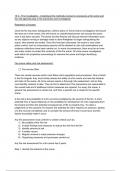10 C - Fire investigation - Understand the methods involved in processing a fire scene and
the role agencies play in fire prevention and investigation
Restriction of Access:
Once the fire has been extinguished, uniform police or Crime Scene Investigators will secure
the area as a crime scene, this will ensure no unauthorised person can access the scene
once it has been secured. The police and the firemen will discuss relevant information such
as any objects moving or damage made to allow firefighters to begin extinguishing the
scene, who entered and exited. Once this has been discussed, the scene is now under
police control, and no unnecessary persons will be allowed on site until examinations and
evidence collections have been carried out. In some circumstances, there must be an inner
and outer cordon to protect the continuity of the fire scene. All crime scene investigators
work within the properties surroundings to examine the scene and begin identifying
evidence.
Fire scene safety and risk assessment:
Fire service Role:
There are certain services which must follow strict regulations and procedures. One of which
is the fire brigade, they must strictly assess the safety of a fire scene and note the hazards
and risks at the scene. All crime scenes require a thorough risk assessment, and so they
must identify cautions to take. They do this to determine if fire precautions are reasonable to
the overall risks and if additional control measures are required. For every fire scene, a
general risk assessment is carried out, and then a specific one is made for the specific
scene.
A fire risk is the probability of a fire occurring multiplied by the severity of the fire. A harm
potential from a hazard depends on the possibility for development of a fire originating from
the hazard and then the potential consequences of life or property loss. To make a
judgement on the outcome of a hazard, the potential for harm requires an assessor. Ignition
of a fire must be considered, and to consider the amount of times it could recur and the
factors to possibly make it occur.
Any fire assessment must conform to certain criteria such as:
1) Be suitable of the fire risk
2) Include findings and measures to reduce the risk from the fire
3) Identify persons at risk
4) A written record
5) Regular reviews to meet premises changes
6) Organising measures and processes carried out
Any fire risk assessment for a fire scene has 5 parts:
Step 1: Identify fire hazards at the scene
, Identify ignition sources (naked flames, radiators, heater)
Identify fuels (waste, textiles, overstock materials)
Identify oxygen sources (air conditioning, oxygen supplies)
Identify structural features (large combustible material areas)
Step 2: Identify people at risk on site:
People asleep on the premises
Large numbers of people
Unfamiliar with the blueprint of the building
Anyone exposed to the fire / fumes
Impairments or disabilities
Children or babies or pregnant women
The elderly
Step 3: Evaluate if the existing fire safety arrangements are suitable or need improving:
Firstly, the fire must be classified as low, medium or high risk and then if the fire was to
recourse would it be of low, moderate or extreme harm. Once all this information is gathered,
the fire brigade completes a table which will determine the risk rating of the fire.
If the existing safety measures are confirmed as being unsatisfactory, any fire hazards,
where possible, must be removed to reduce the risk levels identified.
Step 4: Record findings, make an emergency plan, begin instructing the first plans of action
Step 5: Regularly review the risk assessment:
Upon entering a fire scene, specific details will be accounted for to create the plan by
surveying the whole fire scene. As a result, a dynamic risk assessment is used, it's specific
to that scene. A dynamic risk assessment must detail information about hazards and the
evacuation status, identifying possible need to rescue persons and formulating a plan of
action.
In addition, the fire braids will consider:
Fire control information
Site specific information
On site personnel advice
Building structure and materials
Are all persons accounted for
Type of fire detectors (smoke alarms) in the building
Any fixed installations (sprinklers)
Design features which may assist firefighters
Access to enter the scene at all points




